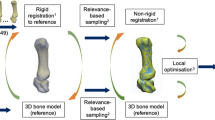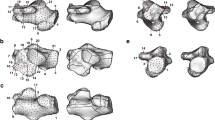Abstract
The shapes of articular surfaces in human metacarpals differ considerably from those in African apes, and such distinctive human morphological characteristics are considered to be strongly linked to dexterous manipulative capabilities that have evolved in the human lineage. However, no detailed studies have quantitatively compared the morphology of the articular surfaces of the metacarpals. We here propose a method for quantifying the orientation and curvature of distal articular surfaces in the 5 metacarpals and proximal saddle surface in the 1st metacarpal via quadric surface approximation. This method utilizes detailed digital models of metacarpals constructed using a 3D noncontact digitizer, and approximates the articular surfaces using a paraboloid to calculate the orientations of the surfaces with respect to the diaphyses and curvature. To demonstrate efficacy of the proposed method, we applied the technique to analysis of the articular surface variation in a total of 98 metacarpals from 10 humans and 11 chimpanzees. The results show that the distal and proximal surfaces of the 1st metacarpal in humans were significantly more axially twisted in a pronating direction; hence, the human thumb pronates and faces the palm and the other fingers with flexion of the first carpometacarpal joint. Further, the head of the 2nd metacarpal in humans is significantly twisted in a pronating direction and the torsion of the metacarpal head gradually shifts toward supination approaching the 5th metacarpals. The proposed method allows quantitative description of such interspecific variations in metacarpals, suggesting its effectiveness for the assessment of the morphological affinities of metacarpals in hominoids.



Similar content being viewed by others
References
Christie, P. W., & Ridley, J. N. (1990). Classification and mathematical representation of synovial articular surfaces. In G. H. Sperber (Ed.), From apes to angels: Essays in anthropology in honor of Phillip V. Tobias (pp. 111–117). New York: Wiley-Liss.
Deane, A. S., Kremer, E. P., & Begun, D. R. (2005). New approach to quantifying anatomical curvatures using high-resolution polynomial curve fitting (HR-PCF). American Journal of Physical Anthropology, 128, 630–638.
Degeorges, R., & Oberlin, C. (2003). Measurement of three-joint-finger motions: Reality or fancy? A three-dimensional anatomical approach. Surgical and Radiologic Anatomy, 25, 105–112.
Lewis, O. J. (1977). Joint remodeling and evolution of human hand. Journal of Anatomy, 123, 157–201.
Lewis, O. J. (1989). Functional morphology of the evolving hand and foot. Oxford: Clarendon Press.
MacConaill, M. A. (1973). Structuro-functional classification of synovial articular units. Irish Journal of Medical Sciences, 142, 19–26.
Marchi, D. (2005). The cross-sectional geometry of the hand and foot bones of the Hominoidea and its relationship to locomotor behavior. Journal of Human Evolution, 49, 743–761.
Marzke, M. W., & Marzke, R. F. (2000). Evolution of the human hand: Approaches to acquiring, analysing and interpreting the anatomical evidence. Journal of Anatomy, 197, 121–140.
McFadden, D., & Bracht, M. S. (2005). Sex differences in the relative lengths of metacarpals and metatarsals in gorillas and chimpanzees. Hormones and Behavior, 47, 99–111.
Napier, J. R. (1961). Prehensility and opposability in the hands of primates. Symposia of the Zoological Society of London, 5, 115–132.
Niewoehner, W. A. (2001). Behavioral inferences from the Skhul/Qafzeh early modern human hand remains. Proceedings of the National Academy of Sciences of the United States of America, 98, 2979–2984.
Niewoehner, W. A. (2005). A geometric morphometric analysis of Late Pleistocene human metacarpal 1 base shape. In D. Slice (Ed.), Modern morphometrics in physical anthropology (pp. 285–298). New York: Kluwer.
Niewoehner, W. A. (2006). Neanderthal hands in their proper perspective. In T. Harrison & K. Harvati (Eds.), Vertebrate paleobiology and paleoanthropology. Neanderthals revisited: New approaches and perspectives (pp. 157–189). New York: Plenum Press.
Ogihara, N., Kunai, T., & Nakatsukasa, M. (2005) An anatomically based 3-D musculoskeletal model of the human hand for evaluation of precision grip capabilities. American Journal of Physical Anthropology, 126(S40), 164.
Ogihara, N., Makishima, H., Aoi, S., Sugimoto, Y., Tsuchiya, K., & Nakatsukasa, M. (2009). Development of an anatomically based whole-body musculoskeletal model of the Japanese macaque (Macaca fuscata). American Journal of Physical Anthropology, 139, 323–338.
Peters, D., & Koebke, J. (1990). Torsion der Metakarpalia II bis V: Funktionelle und klinische Bedeutung. Handchirurgie, Mikrochirurgie, Plastische Chirurgie, 22, 191–195.
Rohlf, F. J. (1990). Fitting curves to outlines. In F. J. Rohlf & F. L. Bookstein (Eds.), Proceedings of the Michigan Morphometrics Workshop (pp. 167–177). Ann Arbor, MI: University of Michigan Museum of Zoology.
Roy, T. A., Ruff, C. B., & Plato, C. C. (1994). Hand dominance and bilateral asymmetry in the structure of the 2nd metacarpal. American Journal of Physical Anthropology, 94, 203–211.
Sarringhaus, L. A., Stock, J. T., Marchant, L. F., & McGrew, W. C. (2005). Bilateral asymmetry in the limb bones of the chimpanzee (Pan troglodytes). American Journal of Physical Anthropology, 128, 840–845.
Singh, I. (1979). Torsion in metacarpal bones and bilateral asymmetry. Journal of Anatomy, 129, 343–349.
Susman, R. L. (1979). Comparative and functional-morphology of hominoid fingers. American Journal of Physical Anthropology, 50, 215–236.
Susman, R. L., & Creel, N. (1979). Functional and morphological affinities of the subadult hand (OH7) from Olduvai Gorge. American Journal of Physical Anthropology, 51, 311–331.
Tocheri, M. (2007). Three-dimensional riddles of the radial wrist: Derived carpal and carpometacarpal joint morphology in the genus Homo and the implications for understanding the evolution of stone tool- related behaviors in hominins. Ph.D. dissertation: Arizona State University.
Tocheri, M. W., Marzke, M. W., Liu, D., Bae, M., Jones, G. P., Williams, R. C., et al. (2003). Functional capabilities of modern and fossil hominid hands: Three-dimensional analysis of trapezia. American Journal of Physical Anthropology, 122, 101–112.
Tocheri, M. W., Razdan, A., Williams, R. C., & Marzke, M. W. (2005). A 3D quantitative comparison of trapezium and trapezoid relative articular and nonarticular surface areas in modern humans and great apes. Journal of Human Evolution, 49, 570–586.
Tocheri, M. W., Femiani, J. C., Orr, C. M., & Marzke, M. W. (2006) Quadric-based metrics for shape analysis of three-dimensional osteological surfaces. American Journal of Physical Anthropology, 129(S42), 177–178.
Tocheri, M. W., Orr, C. M., Larson, S. G., Sutikna, T., Jatmiko, Saptomo, E. W., et al. (2007). The primitive wrist of Homo floresiensis and its implications for hominin evolution. Science, 317, 1743–1745.
Trinkaus, E. (1989). Olduvai hominid-7 trapezial metacarpal-1 articular morphology -contrasts with recent humans. American Journal of Physical Anthropology, 80, 411–416.
Tuttle, R. H. (1967). Knuckle-walking and the evolution of hominoid hands. American Journal of Physical Anthropology, 26, 171–206.
Wunderlich, R. E., & Jungers, W. L. (2009). Manual digital pressures during knuckle-walking in chimpanzees (Pan troglodytes). American Journal of Physical Anthropology, 139, 394–403.
Acknowledgment
We thank Prof. Christoph P. E. Zollikofer, Dr. Marcia Ponce de Leon, and Dr. Kristian J. Carlson, University of Zurich, and Dr. Tomo Takano, Japan Monkey Centre, for their kind permission to study the materials under their care. This study was supported by a Grant-in-Aid for Scientific Research (no. 17687024) and a Grant-in-Aid for Scientific Research on Priority Areas “Emergence of Adaptive Motor Function through Interaction between Body, Brain and Environment” from the Japanese Ministry of Education, Culture, Sports, Science and Technology.
Author information
Authors and Affiliations
Corresponding author
Rights and permissions
About this article
Cite this article
Matsuura, Y., Ogihara, N. & Nakatsukasa, M. A Method for Quantifying Articular Surface Morphology of Metacarpals Using Quadric Surface Approximation. Int J Primatol 31, 263–274 (2010). https://doi.org/10.1007/s10764-010-9397-3
Received:
Accepted:
Published:
Issue Date:
DOI: https://doi.org/10.1007/s10764-010-9397-3




